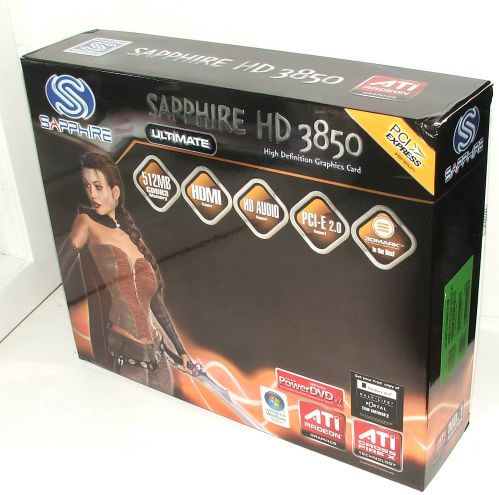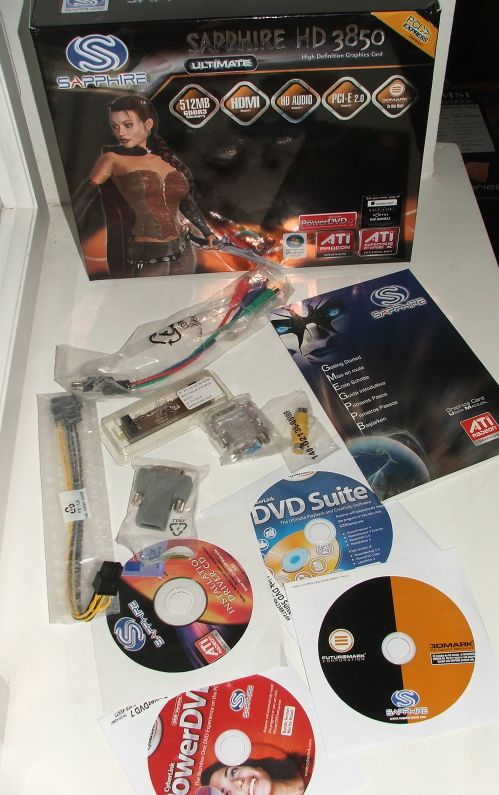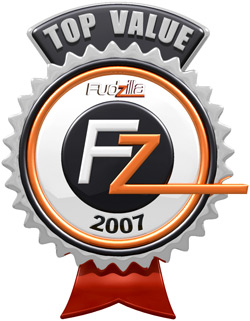We managed to get our hands on one of the first Sapphire Radeon HD 3850 512MB GDDR3 samples, and we can all finally see what this card can and can’t do. The best thing about this card is that, although it runs at reference 670MHz core and 1660MHz memory, this card is passively cooled. We thought that a 55nm chip would be cool enough, but reference card temperatures easily hit 89 degrees Celsius. Sapphire's passive cooler is a bit more efficient, and their temperatures go up to 82 degrees. With a little help from a small fan blowing in the direction of the card, the temperatures dropped to 60 degrees Celsius. That’s the beauty of good passive cooling – if you have good airflow, the card will end up cool and with next to no noise.

Sapphire’s passive cooler has three heatpipes routing the heat to the radiator placed on the back of the card. The card supports Crossfire, comes with 512MB GDDR3, supports HDMI and, of course, you get a free copy of Black Box Half Life 2. This time, you also get a copy of 3DMark 2006.

The cooler hugs the card and the heatpipes go through the entire radiator and transfer heat to all the aluminum fins. You don’t need a fan because radiator size is enough for cooling.

The "Fueled by Sapphire" cooler is made of aluminum and it's pretty light, in spite of its size.

The memory also touches the cooler, and the board houses 8 Qimonda memory modules. You can see the memory modules layout on the cooler, because it left a visible mark in the thermal paste on the cooler.

Three heatpipes stretch from the copper core and go around the card to the other side. Compared to their starting point, their finish line is just a couple of centimeters off.

The only problem with this cooler design is that it makes the card wider. Some motherboards might have big chipset coolers that just might make it impossible to install.

We haven’t had any problems with our EVGA 680i motherboard, but OCZ's Reaper memory modules are a tad bigger than conventional memory kits, so the card leans against and touches the memory. It didn’t affect the performance, but we prefer that components don’t touch.
So, Sapphire Ultimate HD 3850 is a dual slot card but not quite. Unlike standard cards that have big coolers, Sapphire’s card takes up the space behind the card. Still, it’s a great card, it’s silent, has HDMI and audio and you can use it to play all games.
Radeon HD 3850 and 3870 kept R600’s 320 Stream processors, but they are using a 256 bit memory controller. UVD video engine, previously exclusive to mid-range products, is now featured on RV670 cards, also. This enables full acceleration while working with High Definition movie formats H.264 or VC-1. HDMI support with sound is a standard feature on ATI’s HD series, and although Sapphire doesn’t have HDMI out, you can use the DVI-to-HDMI dongle that you get with your card.

The box is made in the usual Sapphire style; it’s compact and filled with content, whereas if you need to check out the most important specs, you can see them on the box. You have PCIe 2.0, HDMI and HD Audio, as well as ATI Crossfire X, although the drivers for it dictate the tempo, so that feature won’t work until early next year. The full model name is Sapphire Ultimate HD 3850 512MB GDDR3 PCIe DUAL –I/TVO, and the card supports DX10.1 and Shader model 4.1. Besides the great features that this card brings, in the box you’ll also receive PowerDVD 7, Futuremark 3DMark06 and The Black Box with Half Life 2, Portal and Team Fortress.

Benchmarking
Sapphire 3850 Ultimate runs at default clocks, but keep in mind that this is a passive card. Sapphire is the first one to put passive cooling on their new 55nm chip. The card itself is quite appealing, and 512MB definitely makes a difference, especially knowing that majority of available HD 3850’s have only 256MB. The memory increase provided a performance boost, and since textures in newer games definitely crave more memory, it’s proven to be quite helpful. You’ll soon see that Sapphire 3850 Ultimate is better than HD 3850 (identically clocked) with 256MB of memory.
Testbed:
Motherboard:
EVGA 680i SLI (Supplied by EVGA)
Processor:
Intel Core 2 Duo 6800 Extreme edition (Supplied by Intel)
Memory:
OCZ FlexXLC PC2 9200 5-5-5-18 (Supplied by OCZ)
while testing CL5-5-5-15-CR2T 1066MHz at 2.2V
PSU:
OCZ Silencer 750 Quad Black ( Supplied by OCZ)
Hard disk:
Seagate Barracuda 7200.9 80GB SATA (Supplied by Seagate)
CPU-Cooler:
Freezer 7 Pro (Supplied by Artic Cooling)
Case Fans:
Artic Cooling - Artic Fan 12 PWM
Artic Cooling - Artic Fan 8 PWM
Futuremark tests

In 3DMarks, Sapphire Ultimate beats the reference card by a small margin. The memory did its job well, and it earned this card a result of 9745 marks in 3DMark06. That’s better than the reference HD 3850 card by 234 marks.
Gaming

Sapphire Ultimate beats the reference HD 3850 by about 6%. That’s only a couple of frames more, but bear in mind that Sapphire HD 3850 Ultimate will be completely silent during the task.

World in Conflict is a game where that extra 256MB of memory will definitely prove to be a good investment. At 1280x1024 and antialiasing on, gaming with reference ATI 3850 is out of the question. Sapphire Ultimate, on the other hand, will have no trouble whatsoever. At this resolution HD 3850 Ultimate beats HD 3850 256MB by about 25%, whereas at 2048x1536 it wins by 40%. However, this doesn’t mean that you’ll have pleasant gaming at these high resolutions, because even our overclocked GTX barely managed to get a decent and flowing frame rate.

In Company of Heroes, Ultimate HD 3850 with 512MB of memory beats ATI’s reference HD 3850 with 256MB of memory by 16%.
Temperatures
Initially, we were quite skeptical about Sapphire’s passive cooler, but we were pleasantly surprised. The core temperature was 7 degrees Celsius cooler than the temperature we measured on the reference card. If you want an even better result, you can place a large and quiet fan near the card that will help make this card even cooler. This method enabled us to lower the temperature to 64 degrees Celsius. A silent card is simply a great thing, especially considering that its cooler does a better job than the reference one.

Conclusion
If you want a passive card, Sapphire HD 3850 Ultimate is one of the best cards that money can buy at the moment. With HDMI and DX10.1 support, this is the card that will serve you for a long time. With 512MB GDDR3 memory and a 670MHz core, you can play all the latest games and enjoy the quiet.
Apart from some installation compatibility issues (the card might lean on your chipset cooler or memory modules) we have no complaints with Sapphire HD 3850 Ultimate. We recommend this card to anyone who might want a passive card that offers good performance at a reasonable price.
It's one of the fastest passively cooled DX10 cards on the market, and the only passive DX10.1 card so far, or should we say the only passive HD3800 series card. Thanks to its multimedia capabilities and silent running it's also an excellent choice for a powerful HTPC, which could bring HD gaming to your living room TV. It is modestly priced, too. The asking price in the EU is around 180 Euro and it should be available in a couple of weeks. All things considered, it wins our Top Value award hands down.



